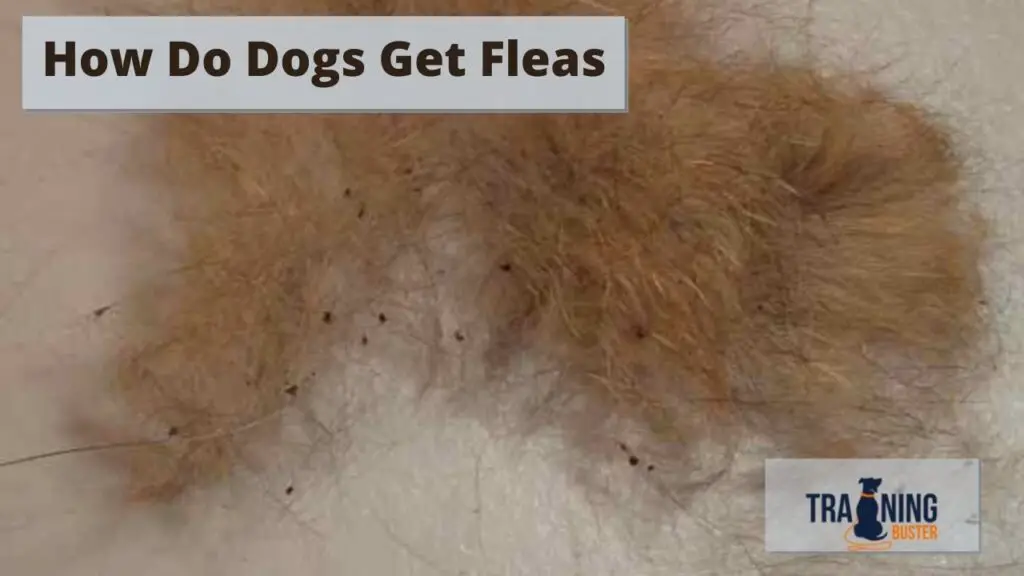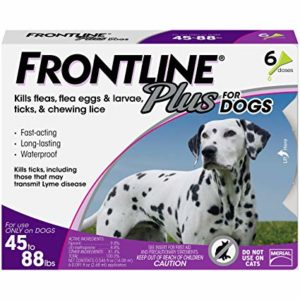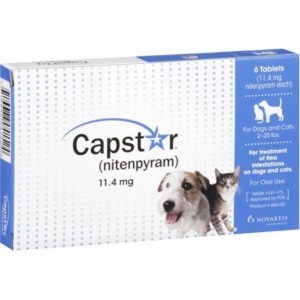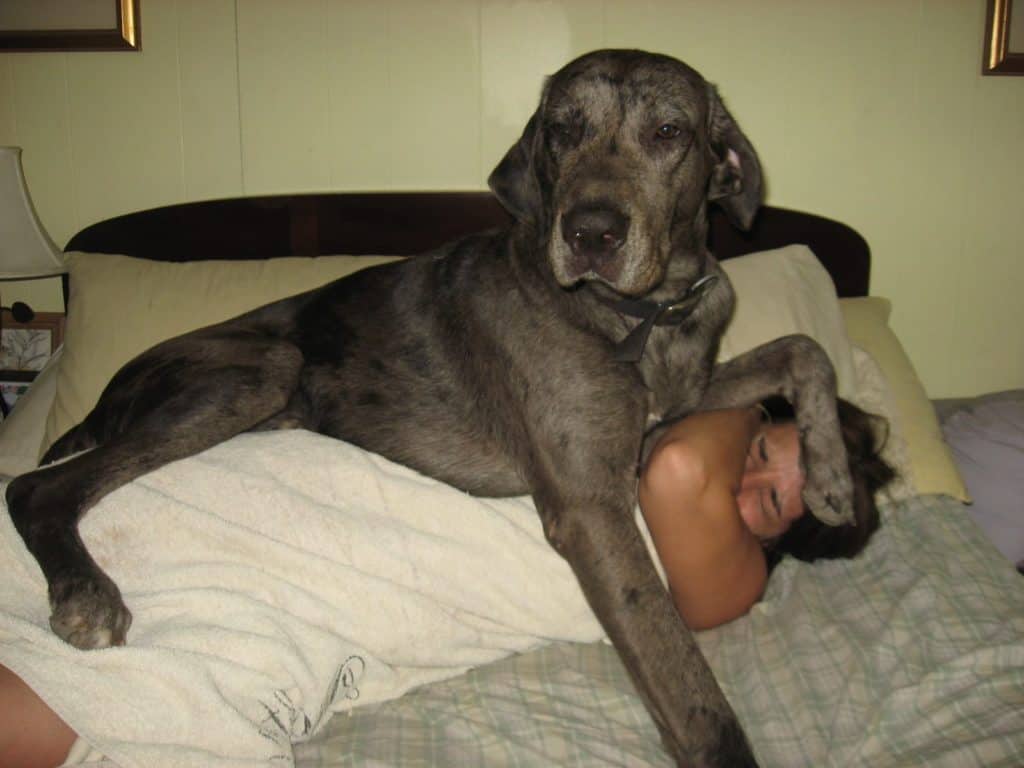
If you ask any dog owner about his worst nightmare, chances are he will tell you it is a flea infestation. Fleas are a real menace. These tiny blood-sucking buggers feed off of your dog causing irritation and anxiety.
And if not checked immediately, they don’t take too long to get to a stage of full-fledged infestation of the yard, the pet, and your house. If this is your first time dealing with a flea infestation, it is probably because you have been careful about preventing a possible one for a long.
But it doesn’t take much to infect a dog, really. Fleas are abundant in nature and quite easily end up being a bother even if your dog primarily stays at home.
Dogs catching fleas from outside animals
Tragically, there is no real way to keep each wild creature out of your yard – not even with a tall fence. No yard is an island unto itself, and squirrels, raccoons, and other little rodents will discover approaches to get into your yard, conveying bugs and ticks alongside them.
The more wild animal visitors you have to your yard, the more prominent the possibility of an invasion touching base on the back of another creature. Non domesticated felines wandering your property are likewise bearers of insects and ticks.
This is one reason not to let wild creatures come into your doggy’s space by forgetting contributions, for example, corn, nuts, and seeds. Indeed, even a bowl of water, or forgotten when your canine is outside, is a a chance for different creatures to hang about.
Contact with outside pets is the main wellspring of fleas and ticks for puppies. While these insects cannot fly, they can bounce shockingly far and will promptly jump to another host to sustain and lay eggs.
On the off chance that your canine isn’t ensured by an insect safeguard, permitting communication with outside pets will put the doggy in question at high hazard for bugs. Different creatures are likewise a stress as feline insects will joyfully overrun hounds.
Indeed, even pooches kept solely inside or far from different pets can contract bugs by means of rat pervasions or contact with other insect-bearing creatures. Doggy daycare and boarding kennels are one more wellspring of bugs.
While most daycare and boarding kennels expect puppies to be without bugs, their parasite checks may not generally be exhaustive, and any untreated mutts are in danger to the parasites.
Direct contact isn’t fundamental as shared toys, bedding, and even an insect pervaded enclosure can cause the issue.
Making a trip to warmer climates can likewise result in a bug invasion for your canine. Insects can invest more energy off of their hosts and in nature when it is warm, simply trusting that a host will jump on.
This is another way hounds contract insects without creature or pet contact. Counteractive action is the most ideal approach to manage insects. While the classic flea collar can be not too bad at counteracting bugs, it is commonly a poor treatment for a functioning insect invasion.
Keep in mind, it just takes a solitary female bug to start an invasion. To keep your puppy and home bug free, be cautious with any bug counteractive action strategy you eventually pick.
Flea transfer on humans
You and your human visitors can also be unwitting carriers of fleas and ticks. Anyone coming into your home could be a carrier of fleas. They can be brought in from the person’s own home or pet without their knowledge.
If you like to spend time hiking in areas where fleas and ticks are prevalent, it’s easy for a few to hitch a ride on your pants leg, socks, shoes, etc. These parasites are well-adapted at finding ways to attach to potential hosts in order to find their next blood meal.
Outside the house
Anytime your pet goes out into the world — even if only for short walks around the block. Playdates at the local dog park; a visit to the veterinarian; a stint at the boarding kennel; a trip to the groomer; a ride in the car; etc. She is being exposed to the opportunity for fleas and ticks to hop aboard.
You may be very careful about checking your dog for ticks after a good hike in the woods or a trip down to the lake. But ticks (and fleas) are good at hiding and they will find the furriest spots in the deepest crevices of your pet’s skin.
Look especially close in the neck fur, in the abdomen, and in the arm “pits.”
Being proactive
Because fleas and ticks are so good at what they do, you will need to be extra vigilant during the peak flea and tick season. Typically the warm weather months from spring through early autumn (in the southern states, flea and tick season can be all year long).
If you notice just one or two insects on your dog, treat it seriously, before it becomes a full-blown infestation. If your dog is very young or old, or if she has any underlying health condition, visit your veterinarian for advice on the best preventive medications and the safest way to use them.
Your doctor will be able to show you the proper way to apply these medications and recommend just the right dose for your dog’s age and weight.
If you catch the problem quickly enough, you may be able to avoid chemical solutions and try natural solutions first.
One solution is anti-pest landscaping. For the outside, there are some plants that are known for their flea repelling characteristics, and it is worth it to try anti-pest landscaping. However, it is often easier and more effective to use chemical pesticides and repellants for yard and perimeter treatment, especially when dealing with an infestation that is already in full progress.
If you do already have a flea and tick problem, you might want to use the tried and sure chemical remedies for this season. So that you can comfortably enjoy the rest of the season, saving the reliance on flea repelling landscaping for next spring.
It’s much easier to start early, keeping parasites from getting a foothold, than it is to try to eradicate them after they have had a chance to breed and establish themselves in your home and on your dog.
How to know if there is a flea infestation?
Itching is usually a sure sign of a flea infestation. So is finding a flea on your dog (or yourself). On average, adult fleas can live from several weeks to several months. If you’ve found fleas on your dog or around your house, you could be dealing with a major infestation. And you may not even know it yet.
For every adult flea you see, there are way more in the 3 other stages of development (pupae, larvae and eggs) that you don’t spot. Up to 95% of fleas exist in these 3 stages.
If you notice your pets scratching, chewing, licking or biting themselves more than normal, it’s time to take a closer look at their fur. Fleas will typically congregate on the back half of your dog or cat’s body, inside the back legs, at the base of the tail or on the belly and groin — wherever is warm and protected.
Part your pet’s hair with a flea comb or your fingers to look for these high-jumping pests, and the detritus they leave behind.
“Flea dirt” (brown specks on your dog’s skin or in their fur) can also be signs of an infestation.
You can perform a “spot test” by collecting this dirt on a piece of white paper or a paper towel and adding a splash of water.
If you see red staining when the water and brown specks mix, then this “dirt” is most likely a flea’s digested meal.
If your dog gets especially itchy from flea bites, he’s not alone. Flea allergy dermatitis (FAD) is the most common allergic condition in dogs with symptoms developing at between 1 and 3 years of age.
This reaction, caused by the flea’s saliva, can lead some dogs to experience itching, scratching, and skin infections. While dogs without this sensitivity will be perfectly fine — similar to how people react differently to mosquito bites.
For a dog with FAD, just one bite can make him itchy for days. If you suspect your dog or cat is suffering, look for red, raised bumps, scabs, scaling, red skin and salivary staining (from licking), even missing fur.
Prevention and treatment
The best way to deal with fleas is prevention. Flea and tick preventatives kill fleas that come in contact with your dog, preventing your pup from bringing them home in the first place.
There are several options out there, from flea collars to liquid applicants and pills. Talk to your vet about the flea preventative that is right for your dog. If your dog already has fleas, these preventatives will still kill them, but you may need to take more aggressive action, like a prescription preventative.
You can also use a flea shampoo or a fast-acting chemical treatment, such as a pill that kills the fleas on your dog within hours.
As we said. We recommend Frontline Plus for Dogs. It has thousands of great reviews on Amazon. You can find the customer reviews and the latest price here.
Removing fleas from your dog
Give Your Pet a Bath
Just lukewarm water, or water and mild soap, can help get fleas off your pet’s fur and skin. If you’re thinking about using a flea shampoo or something similar, talk to your veterinarian first. If your pet is allergic to fleas (your vet may call it flea allergy dermatitis), its skin might be especially sensitive.
That’s also true if your pet has any other open wounds or “raw spots” on its skin. Some of the chemicals in flea products can make irritation and infections worse.
You can find every flea shampoo under the sun on Amazon. you should read the customer reviews and latest prices here.
Comb Your Pet’s Hair Using a Fine-Tooth Flea Comb
The teeth on a flea comb are spaced to trap fleas while they allow your pet’s fur to pass through. Flea combs also help remove flea poop, sometimes called “flea dirt” — dark brown or black specks that look like pepper flakes.
Be sure to take special care while you comb around your pet’s neck and tail areas. That’s where fleas tend to feed.
Kill dog Fleas
The little buggers are usually between the size of a poppy seed and a sesame seed, and they’re brown or reddish-brown. If you see a flea on the flea comb, dunk the comb into hot, soapy water to kill the flea.
Don’t try to crush fleas. They jump quickly and can be hard to kill by hand.
Do Regular Checks
If your pet has a history of fleas, comb your friend with a flea comb at least once a week until you’re sure that your home and pet are free of fleas.
Let Your Pet Groom Itself
Cats clean themselves more when they have fleas. They’re not just itching. Researchers say the extra work helps cats get rid of fleas. Many dogs also groom themselves more often when they have fleas.
In most cases, that’s OK. But if your pet is nipping, chewing, or scratching at itself enough that you notice hair loss or red, inflamed, or bloody skin, call your vet right away.
Your animal may have an infection or a flea allergy. Keep in mind that you may not find fleas on your pet, even if your vet has confirmed your pet has been bitten by fleas.
They live in carpets, bedding, and other surfaces in your home. They jump onto pets (and sometimes humans) to eat, but they usually don’t stay once they’re done eating.
If you’re not sure if your pet has fleas, see your vet make sure.
Home remedies for treating flea infestation
Over-the-counter medication
There are several medications and medicated products that prevent flea infestations on your dog. You’re probably familiar with the spot-on topical treatments that you get from the vet and apply to your dog’s back for monthly relief.
These are usually effective, though some dog owners are concerned about potential side effects and toxins. There are also medicated powders that provide weekly protection and shampoos that are only effective for about a day.
Certain medications are also available in pill form and can provide monthly protection. All of these options should be researched and discussed with your veterinarian before giving them to your dog.
While they may be effective at treating fleas, they may also result in side effects in your dog that you’re not comfortable with. Consider all options before making a decision.

Frontline Plus for Dogs. Great customer reviews. Find it here.

Capstar Fast-Acting Oral Flea Treatment for Dogs. Also thousands of customer reviews. Also sold on Amazon for a cheaper price, you can find it here.
Apple Cider Vinegar – Available here.
Apple cider vinegar can be used as a preventative flea treatment in several ways. While it doesn’t actually kill fleas, it does repel them and make them jump off your dog.
One way to use apple cider vinegar as a preventative treatment is by adding it to your dog’s drinking water. It should be added in the amount of one teaspoon per quart of water, though some dogs may be put off by the taste.
If that is the case, you may want to start with a lower amount and introduce it more gradually to allow your dog to get used to it. Apple cider vinegar can also be made into a spray as a mixture of two parts apple cider vinegar, one part water.
You can use this spray on your dog’s coat and allow it to sink in, or you can dip a comb into the mixture and run it through your dog’s fur. Again, this will not kill fleas, but it should repel them. Avoid contact with your dog’s eyes.
Garlic – Available here.
Wait! Isn’t garlic toxic to dogs? This is a topic of controversy. In most cases, the amount of garlic it would take to make your dog sick is an amount you would never feed your dog.
Some experts claim that there is no evidence that garlic repels fleas, and they say you should never feed your dog garlic. The American Kennel Club, for example, says garlic is a no-no, but even they admit that it.
Takes approximately 15 to 30 grams of garlic per kilograms of body weight” to cause your dog harm, and “the average clove of supermarket garlic weighs between 3 and 7 grams, so your dog would have to eat a lot of garlic to get really sick.
” Some dogs are, however, more sensitive to garlic than others, and it should be avoided by dogs with certain medical conditions, such as diabetes. Other sources and dog owners say that garlic is an effective flea preventative.
Whatever the case, approach with caution and discuss it with your veterinarian. If you decide to give your dog garlic, you should boil it and give it in small amounts. No more than a quarter clove with a meal. Some recommend dusting your dog’s coat with it, as well, though dogs may try to lick it off if they enjoy the taste.
It will take a while to build up in your dog’s system, so you should start giving it to your dog before tick season. Again, please do not give your dog garlic before consulting your veterinarian. There are several other treatment options that can help you prevent fleas and avoid potential risks of garlic, so keep that in mind.
Neem Oil – Available here
Neem oil is extracted from the seeds and bark of the neem tree, which is native to India. It has several uses and medicinal properties, so it can provide plenty of health benefits beyond flea prevention.
It can be diluted with olive or grapeseed oil and dabbed on your dog’s fur (one part neem oil to ten parts other oil) in places where fleas are likely to infest, including the head, ears, tail, shoulders, and flanks. It can be added to shampoo with one teaspoon neem oil and two tablespoons of shampoo, or it can be made into a spray with one part neem oil and ten parts water.
The main problem is that neem oil has a distinct smell that you may find unpleasant. Also, it does not prevent against all types of ticks or tapeworms, so it can’t replace all of your dog’s preventative medication or other treatments.
Don’t let your dog eat it and avoid contact with their eyes and nose.
Store-bought flea collars – We recommended a plant-based one Available here
Flea collars can either prevent fleas, treat an existing infestation, or do both. They can be medicated or emit gas to ward off fleas. These can be effective for up to eight months and are generally a cheaper option than topical medications, but there are some drawbacks.
One is that they are on the neck, which means they are more effective in that area. The head, ears, and neck tend to be where fleas appear most often, but it can leave other parts of the body more exposed.
Another disadvantage is that, like topical medications, the chemicals in flea collars can be toxic. You should discuss this option with your veterinarian and do your research before relying on store-bought flea collars.
Homemade flea collars
For those who want to avoid the chemicals and potential side effects of store-bought collars, you can make homemade flea collars that use more natural ingredients to prevent fleas. These are usually made with essential oils and a bandanna.
The bandanna is soaked in a mixture and placed around the dog’s neck. Some recommended oils to use are lavender, rosemary, thyme, and cedarwood. Garlic oil may also be effective.
The disadvantages of these collars are that they don’t last nearly as long as store bought collars, and they are also more effective around the head and neck area while leaving the rest of the body more open to infestation, but they don’t contain the potentially harmful chemicals.
Eucalyptus – Available here
Eucalyptus is dangerous if consumed by dogs or cats. If you want to use eucalyptus as a flea repellent, make sure you keep it out of reach of all of your pets.
That said, eucalyptus oil can be mixed with water and used as a spray that you can put on carpets and furniture, just make sure to let it dry and make sure your dog doesn’t lick any surfaces that you coat.
You can also spread some eucalyptus leaves and stems in open jars around the home, but again, be sure to place them out of reach of any pets. Fleas hate the scent of eucalyptus and are generally repelled by it.
This is a treatment you should use with extreme care. Ask your veterinarian for some advice.
Diatomaceous earth
Diatomaceous earth is a natural powder derived from rock formed by fossilized algae. It is very fine and abrasive to flea exoskeletons. One of the advantages of this is that fleas do not develop immunity to it. It kills them quite effectively. You can spread diatomaceous earth on carpet and other surfaces, then vacuum it up after two to three days. Do not put it on your dog’s skin, as it will dry out.
Cedar chips – Available here.
Fleas hate the smell of cedar, and cedar chips can be spread around your yard or outdoor area to prevent them from entering your dog’s environment. The advantage of cedar chips is that they can provide outdoor protection from fleas while you take steps to make your indoor environment safe. Cedarwood oil can also be effective, and it can be mixed with water and used as a spray.
Keeping everything clean
One of the simplest ways to ward off fleas is to keep your indoor environment clean especially with regards to the places your dog likes to go and the items they frequently interact with.
Their bedding, for example, should be thoroughly washed often, as should any furniture or pillows that they like to sleep on, any rugs or carpet that they like to lie on, or any toys and stuffed animals they play with. Vacuuming and washing fabrics regularly will help prevent fleas from taking up residence in your home.
Removing fleas from your home
Killing the fleas on your dog is just one part of the problem. You also need to get the fleas out of your home. This requires patience. In most cases, it takes 3-4 months to get rid of an infestation. As it takes this long for all of the fleas in your home to go through their life stages. Here are the 5 steps you need to take to eradicate fleas in your home:
- Wash all bedding in hot, soapy water.
- Vacuum all carpets, hardwood floors, linoleum and tiled floors, and throw away the vacuum bag.
- Choose and apply an environmental flea control like methoprene, or call a local exterminator.
- Choose and apply a spray, pellet, or non-toxic treatment for your yard
- Continue to treat your dog and any other pets with a monthly preventative.
Removing fleas from your yard
If your dog has fleas, and you’ve found fleas in the house, chances are, there are also fleas in your yard. And there are many natural options that work just as well without putting your dog at risk.
- Mow the lawn and trim down any overgrown hedges and bushes. The fewer places the fleas have to hunker down, the better.
- Remove dead leaves and twigs from flower beds and from under bushes. Remember, fleas like dark, damp places, so clear those out as much as possible. Expose those shady areas to sunlight.
- Use nematodes. Nematodes are tiny worms that feed on organic matter. There are several different kinds of nematodes. Some are good, some are bad, but Steinermacarpocapsea are great! They target (and eat) bugs – including fleas.You can spray nematodes on your lawn and in your garden. They can kill up to 90% of flea larvae in as little as 24 hours. And they’re totally safe for your dog. Better yet, they’re safe for the environment so they don’t damage crops or gardens.
- Plant some flea repelling plants. Rosemary, lemongrass, peppermint and sage have natural oils that repel fleas. Use them to keep the fleas from your yard and away from your dog.
Fleas can be a nightmare, but you don’t need to resort to chemical sprays, spot-ons or chemical-based oral treatments to get rid of them.
Use these tips to get rid of fleas on your dog, in your house, and in the yard. Not only do they work, they’ll also keep the chemicals out of your dog’s system!
Related questions
How can I see and recognize the fleas that are infecting my dog?
Adult fleas are about an eighth of an inch long. They’re reddish-brown and very thin. It’s hard to really see what they look like without a microscope (though it’s easier on a light-colored fur), but they do have big back legs. They can jump, by some measurements, upward and outward at least 12 inches in a single leap.
And one estimation finds that for every adult flea found on your pet, there are at least 100 immature ones hanging around.
My dog is losing hair. Can it be because of the fleas?
It is possible that such is the case. It’s not from the fleas themselves but from all the itching and biting. Fleas often gather at the neck and shoulder blades of your pets.
The base of the tail and along the back of the legs is a favorite hangout for them, too. Those are also places animals will bite to get to the fleas. That can take its toll on a pet’s coat. With full-blown infestations, fleas are visible in the bare areas of a pet’s belly, too.
If you can get past your pet’s fur and look at the skin, fleabites are usually small, raised red dots. Again, look for bites on the back and neck and on the base of the tail. Another problem with fleabites is they can lead to flea allergy dermatitis, also known as fleabite hypersensitivity. If your pet has this, their skin can become itchy, red, and scaly. It can lead to secondary skin infections, too.


